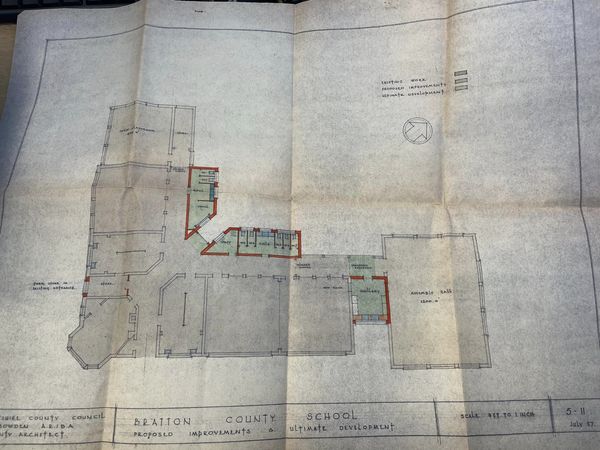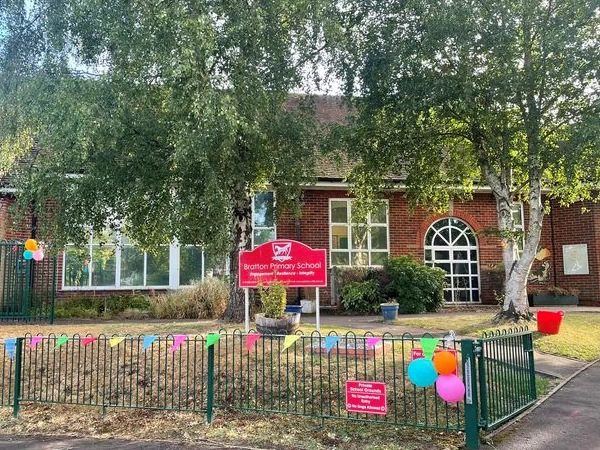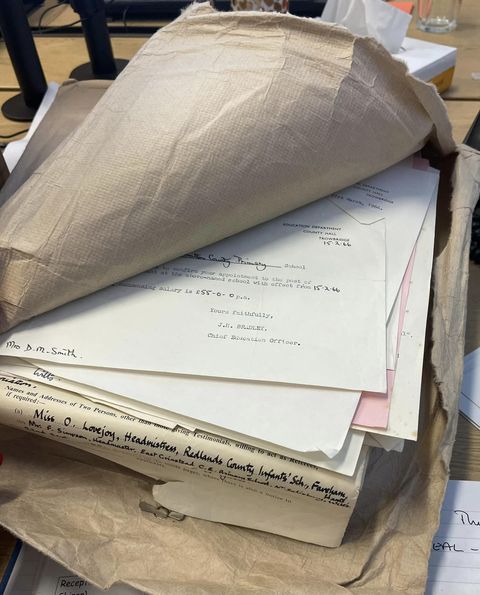


School History
The original school in Bratton was the Old British School built in 1833 and sponsored by the Whitaker Family who were involved in the wool industry and interested in education.
The first school was a very small wooden building on stilts next to the Manse of the Baptist Chapel. There were 100 pupils in the school with 40 in the upper area and 60 in the lower area. The children started at the age of three and a half years and the leaving age was fourteen.
The Teachers
Miss Burgess (Seniors in the lower classroom); Miss Salter (Juniors in the upper classroom). Prior to this there were instructors from families in the woollen industry. Both teachers were in the school from World War 1 until the school closed in 1928. There were very strict tests carried out by special inspectors twice a year. Discipline was very strict and a cane was placed on the teacher’s desk. This was used for cheating, lying or any other disruption. Fidgets were made to stand in the corner facing the wall for ten minutes with their hands on their heads.
The Interior of the school
The school had tortoise stoves which were used to dry wet clothes and shoes in winter. They were surrounded by tall mesh railings. There was gas lighting with a fragile mantle which showered fine dust on the nearest pupil and his/her desk. The teacher’s desk was mounted on a platform which also held a blackboard and easel. Desks were in groups of two and had hard wooden seats and tops which opened. The very young pupils sat on hard wooden small armchairs, with a small table in front.
Bratton Primary School was opened in 1928. It was just three rooms and two teachers. Mr. Cherry was the new headteacher and Miss Burgess, who was the last Headteacher at the recently closed British School, became the class teacher.
On 17th April 2023 Bratton Primary School celebrated its 95th birthday. When the school opened in 1928, it was a simple L-shaped building with three classrooms – Infants, Transition and Top class – for 79 children, aged between 5 and 11. Those children would now be older than your Grandparents. They would have been your Grandparent’s Grandparents. This was a time before TV and traffic was rarely seen in the village.
With fields and orchards on two sides, the school was described as ‘an unusually spacious and attractive rural setting’, and was known as ‘the school with a garden’, being the first in Wiltshire to be given a garden of its own. It is reported that young calves occasionally found gaps in the fence and wandered into the playground. Many children were used to cattle, as they lived on farms around the village and up the hill, and would walk all the way down from Salisbury Plain each morning – and back again in the afternoon. During harvesting season many children stayed home on the farm to help with the harvest. Other children’s fathers worked at the Reeves Iron Foundry, where the village green is today, and back then classes would regularly visit the village blacksmith to watch him at work.
The school inspectors noted ‘the pride of children in their school and their happiness in their school life’. The school had no hall or kitchen, so lunch had to be brought in each day in big stainless steel containers and eaten in classrooms. Even today, children from that time remember that ‘It was custard with everything’.
Public lending libraries were a new idea at this time, and when first introduced to towns and villages in Wiltshire, the headteacher became Bratton’s first honorary librarian, with boxes of 200 books for both adults and children placed in their office that families around the village could borrow. It was so popular that around 80 books were being borrowed each week.
The Winter of 1937 was a hard one for many children, with half off school due to chicken pox, whooping cough, influenza and bad colds. Each year a doctor visited the school to check on each child’s health, and when they looked out of the classroom window and saw a caravan arrive they knew it was the dentist visiting. Not everybody was pleased to see him. One pupil from that time still remembers ‘Once I bit him’.
At the start of September of 1939 the number of children increased by 25 in one day. The Second World War had begun and children living in big cities were evacuated on trains out into the countryside to be safe. These children came and lived with families all around the village until it was safe for them to return to their homes again. This was the first time they would have been to the countryside and seen fields and cows and sheep and pigs. It is said that one or two chose to stay and make Bratton their home.
A new Headmistress, Miss Page, came to the school in 1945 and stayed for 22 years. She encouraged nature studies, including regular lessons held in Happy Valley. Top class all had their own two meter by one meter plot in the garden, and all these years later children from that time clearly remember ‘We were allowed to pick a packet of seeds. I grew Clarkia, tall and very colourful, in circles round and round’. Miss Page also ran a weekly Girls Friendly Society at the school, a bit like Guides, where they played games, had treasure hunts, enjoyed dressing up, and even learnt to play Christmas carols on hand bells.
It wasn’t all fun and games. The boiler used for heating the school needed to be refuelled with coal, and it was Miss Page who did this dirty and dusty job, three or four times a day. It was not until the 1960s that electric plug sockets were added to classrooms to allow children to listen to BBC Schools programmes on the radio, and have an electrically heated fish tank.
When she retired in 1967, Miss Page was presented with an engraved clock and a hand loom, and pupils from that time say that she not only sent them a Christmas card each year for the rest of her life, she even gave them wedding presents when they grew up and married.
Around this time school inspectors had noticed that the average height of children was higher than when the school had opened 45 years before, and that all the desks and chairs were too small for children now. Each time new houses were built in the village, the numbers of children steadily increased until, by the 1970s, the number had doubled since 1928. To begin with a mobile classroom was used for extra space until the school hall and three more classrooms were built in 1982. That mobile classroom is now the toddlers playgroup in the village park.
A full history of education in Bratton can be found at the Bratton History Association.
